NURS2003 - Pneumonia Case Study: Pathophysiology, Symptoms, and ADME
VerifiedAdded on 2023/04/26
|13
|3616
|350
Case Study
AI Summary
This case study comprehensively analyzes bilateral pneumonia in a 32-year-old male with a history of asthma, focusing on the pathophysiology, symptom manifestation, and pharmacological interventions. It begins by detailing the anatomy and physiology of the lungs, explaining how pneumonia disrupts normal respiratory function. The pathophysiology section elaborates on the transmission and development of pneumonia, highlighting risk factors such as asthma and environmental exposures. The role of inhaled corticosteroids and bronchodilators in increasing vulnerability to pneumonia is discussed. Key symptoms like productive cough with green sputum, chest pain, and breathlessness are examined in relation to the underlying pathological processes. The medication section delves into the ADME (absorption, distribution, metabolism, excretion) properties of IV benzylpenicillin and doxycycline, explaining their mechanisms of action in combating bacterial infection. The case study integrates clinical information with pharmacological and pathophysiological principles to provide a holistic understanding of pneumonia management.

Running head: HEALTHCARE
HEALTHCARE
Name of the student:
Name of the university:
Author note:
HEALTHCARE
Name of the student:
Name of the university:
Author note:
Paraphrase This Document
Need a fresh take? Get an instant paraphrase of this document with our AI Paraphraser
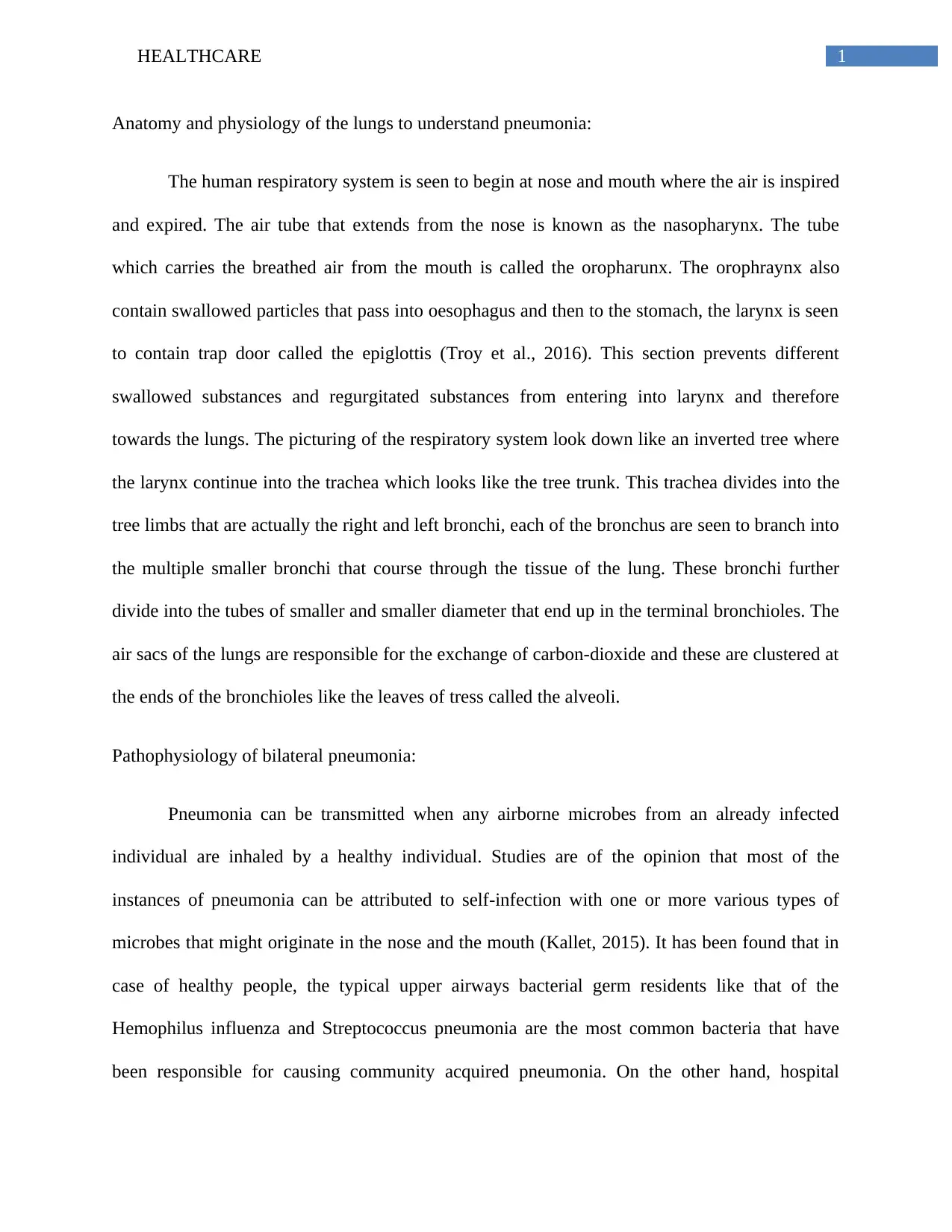
1HEALTHCARE
Anatomy and physiology of the lungs to understand pneumonia:
The human respiratory system is seen to begin at nose and mouth where the air is inspired
and expired. The air tube that extends from the nose is known as the nasopharynx. The tube
which carries the breathed air from the mouth is called the oropharunx. The orophraynx also
contain swallowed particles that pass into oesophagus and then to the stomach, the larynx is seen
to contain trap door called the epiglottis (Troy et al., 2016). This section prevents different
swallowed substances and regurgitated substances from entering into larynx and therefore
towards the lungs. The picturing of the respiratory system look down like an inverted tree where
the larynx continue into the trachea which looks like the tree trunk. This trachea divides into the
tree limbs that are actually the right and left bronchi, each of the bronchus are seen to branch into
the multiple smaller bronchi that course through the tissue of the lung. These bronchi further
divide into the tubes of smaller and smaller diameter that end up in the terminal bronchioles. The
air sacs of the lungs are responsible for the exchange of carbon-dioxide and these are clustered at
the ends of the bronchioles like the leaves of tress called the alveoli.
Pathophysiology of bilateral pneumonia:
Pneumonia can be transmitted when any airborne microbes from an already infected
individual are inhaled by a healthy individual. Studies are of the opinion that most of the
instances of pneumonia can be attributed to self-infection with one or more various types of
microbes that might originate in the nose and the mouth (Kallet, 2015). It has been found that in
case of healthy people, the typical upper airways bacterial germ residents like that of the
Hemophilus influenza and Streptococcus pneumonia are the most common bacteria that have
been responsible for causing community acquired pneumonia. On the other hand, hospital
Anatomy and physiology of the lungs to understand pneumonia:
The human respiratory system is seen to begin at nose and mouth where the air is inspired
and expired. The air tube that extends from the nose is known as the nasopharynx. The tube
which carries the breathed air from the mouth is called the oropharunx. The orophraynx also
contain swallowed particles that pass into oesophagus and then to the stomach, the larynx is seen
to contain trap door called the epiglottis (Troy et al., 2016). This section prevents different
swallowed substances and regurgitated substances from entering into larynx and therefore
towards the lungs. The picturing of the respiratory system look down like an inverted tree where
the larynx continue into the trachea which looks like the tree trunk. This trachea divides into the
tree limbs that are actually the right and left bronchi, each of the bronchus are seen to branch into
the multiple smaller bronchi that course through the tissue of the lung. These bronchi further
divide into the tubes of smaller and smaller diameter that end up in the terminal bronchioles. The
air sacs of the lungs are responsible for the exchange of carbon-dioxide and these are clustered at
the ends of the bronchioles like the leaves of tress called the alveoli.
Pathophysiology of bilateral pneumonia:
Pneumonia can be transmitted when any airborne microbes from an already infected
individual are inhaled by a healthy individual. Studies are of the opinion that most of the
instances of pneumonia can be attributed to self-infection with one or more various types of
microbes that might originate in the nose and the mouth (Kallet, 2015). It has been found that in
case of healthy people, the typical upper airways bacterial germ residents like that of the
Hemophilus influenza and Streptococcus pneumonia are the most common bacteria that have
been responsible for causing community acquired pneumonia. On the other hand, hospital
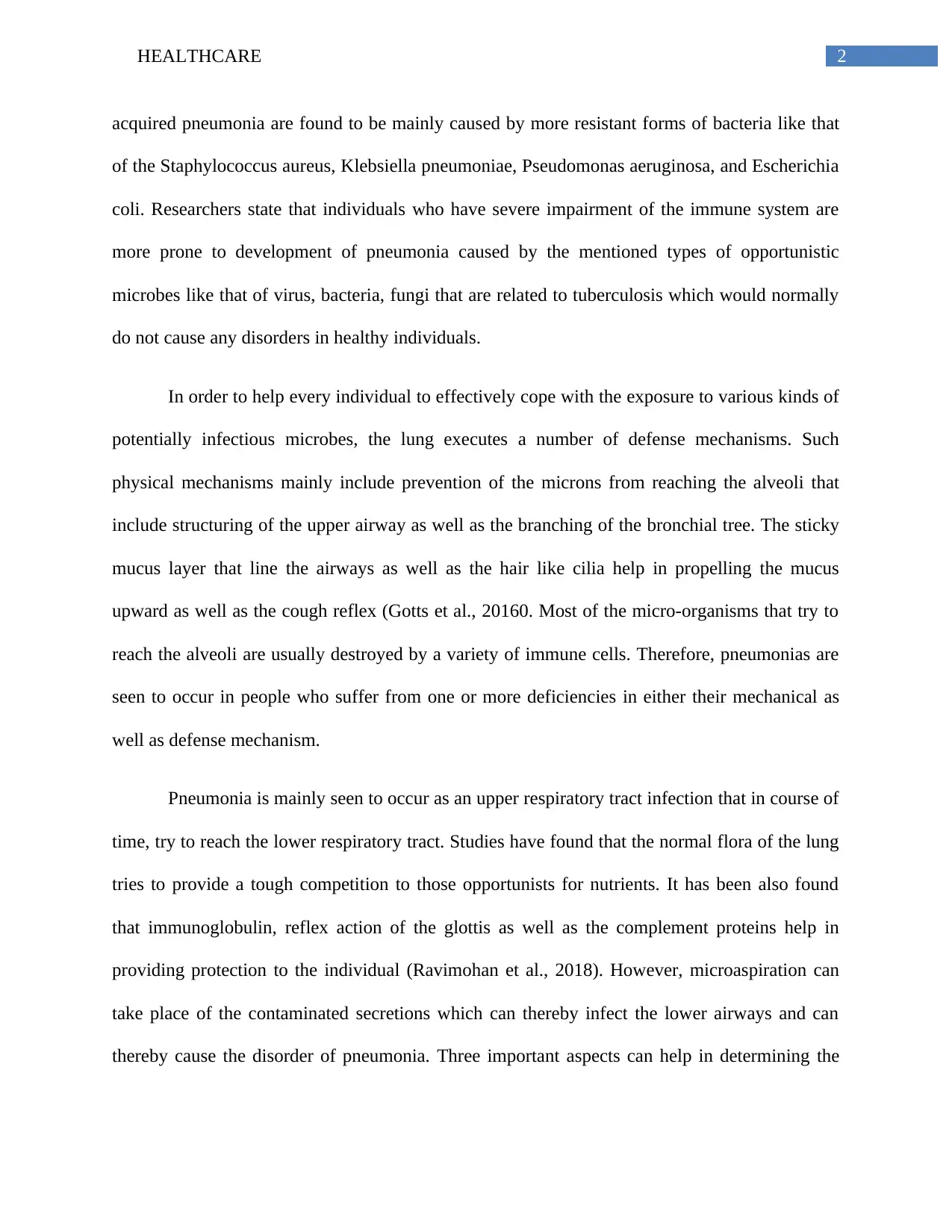
2HEALTHCARE
acquired pneumonia are found to be mainly caused by more resistant forms of bacteria like that
of the Staphylococcus aureus, Klebsiella pneumoniae, Pseudomonas aeruginosa, and Escherichia
coli. Researchers state that individuals who have severe impairment of the immune system are
more prone to development of pneumonia caused by the mentioned types of opportunistic
microbes like that of virus, bacteria, fungi that are related to tuberculosis which would normally
do not cause any disorders in healthy individuals.
In order to help every individual to effectively cope with the exposure to various kinds of
potentially infectious microbes, the lung executes a number of defense mechanisms. Such
physical mechanisms mainly include prevention of the microns from reaching the alveoli that
include structuring of the upper airway as well as the branching of the bronchial tree. The sticky
mucus layer that line the airways as well as the hair like cilia help in propelling the mucus
upward as well as the cough reflex (Gotts et al., 20160. Most of the micro-organisms that try to
reach the alveoli are usually destroyed by a variety of immune cells. Therefore, pneumonias are
seen to occur in people who suffer from one or more deficiencies in either their mechanical as
well as defense mechanism.
Pneumonia is mainly seen to occur as an upper respiratory tract infection that in course of
time, try to reach the lower respiratory tract. Studies have found that the normal flora of the lung
tries to provide a tough competition to those opportunists for nutrients. It has been also found
that immunoglobulin, reflex action of the glottis as well as the complement proteins help in
providing protection to the individual (Ravimohan et al., 2018). However, microaspiration can
take place of the contaminated secretions which can thereby infect the lower airways and can
thereby cause the disorder of pneumonia. Three important aspects can help in determining the
acquired pneumonia are found to be mainly caused by more resistant forms of bacteria like that
of the Staphylococcus aureus, Klebsiella pneumoniae, Pseudomonas aeruginosa, and Escherichia
coli. Researchers state that individuals who have severe impairment of the immune system are
more prone to development of pneumonia caused by the mentioned types of opportunistic
microbes like that of virus, bacteria, fungi that are related to tuberculosis which would normally
do not cause any disorders in healthy individuals.
In order to help every individual to effectively cope with the exposure to various kinds of
potentially infectious microbes, the lung executes a number of defense mechanisms. Such
physical mechanisms mainly include prevention of the microns from reaching the alveoli that
include structuring of the upper airway as well as the branching of the bronchial tree. The sticky
mucus layer that line the airways as well as the hair like cilia help in propelling the mucus
upward as well as the cough reflex (Gotts et al., 20160. Most of the micro-organisms that try to
reach the alveoli are usually destroyed by a variety of immune cells. Therefore, pneumonias are
seen to occur in people who suffer from one or more deficiencies in either their mechanical as
well as defense mechanism.
Pneumonia is mainly seen to occur as an upper respiratory tract infection that in course of
time, try to reach the lower respiratory tract. Studies have found that the normal flora of the lung
tries to provide a tough competition to those opportunists for nutrients. It has been also found
that immunoglobulin, reflex action of the glottis as well as the complement proteins help in
providing protection to the individual (Ravimohan et al., 2018). However, microaspiration can
take place of the contaminated secretions which can thereby infect the lower airways and can
thereby cause the disorder of pneumonia. Three important aspects can help in determining the
⊘ This is a preview!⊘
Do you want full access?
Subscribe today to unlock all pages.

Trusted by 1+ million students worldwide
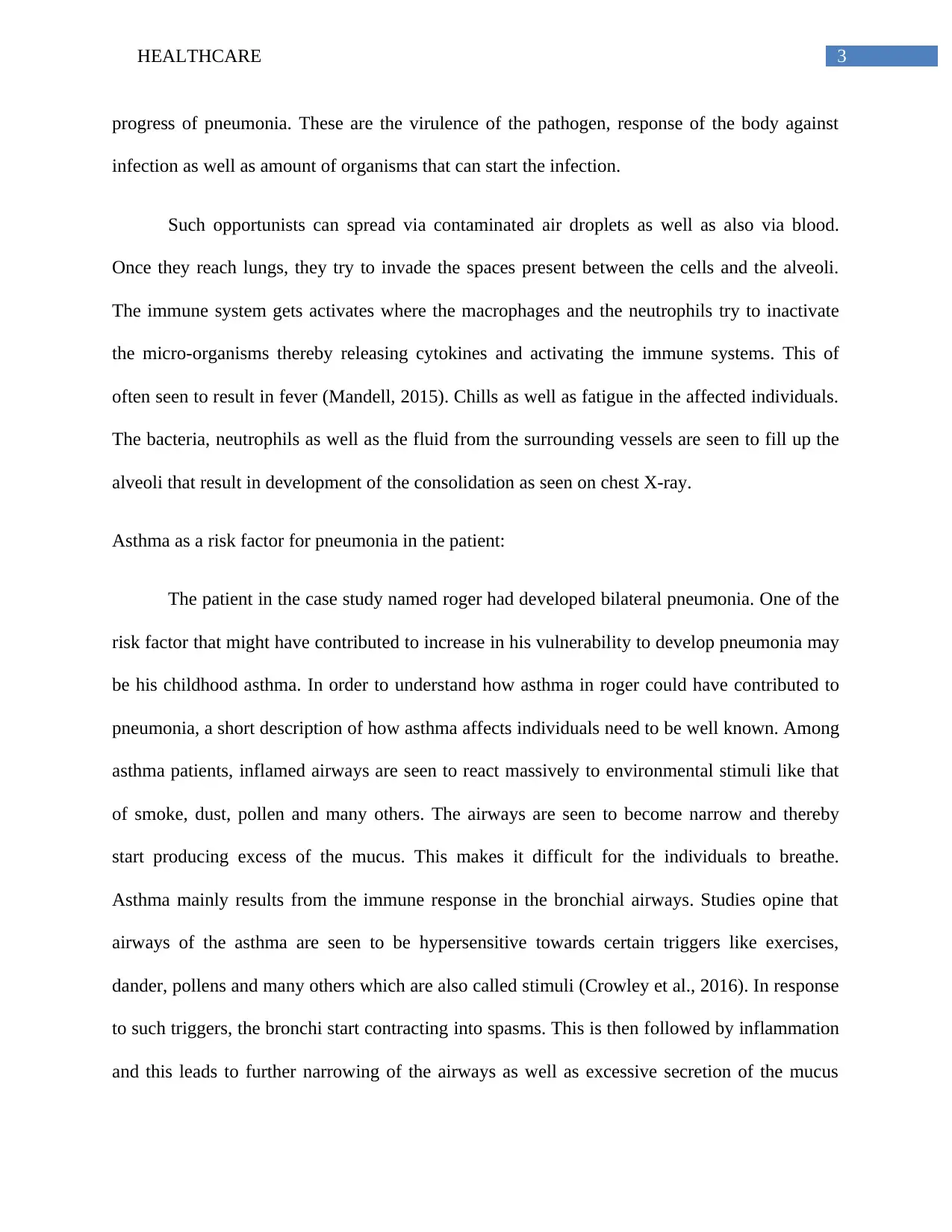
3HEALTHCARE
progress of pneumonia. These are the virulence of the pathogen, response of the body against
infection as well as amount of organisms that can start the infection.
Such opportunists can spread via contaminated air droplets as well as also via blood.
Once they reach lungs, they try to invade the spaces present between the cells and the alveoli.
The immune system gets activates where the macrophages and the neutrophils try to inactivate
the micro-organisms thereby releasing cytokines and activating the immune systems. This of
often seen to result in fever (Mandell, 2015). Chills as well as fatigue in the affected individuals.
The bacteria, neutrophils as well as the fluid from the surrounding vessels are seen to fill up the
alveoli that result in development of the consolidation as seen on chest X-ray.
Asthma as a risk factor for pneumonia in the patient:
The patient in the case study named roger had developed bilateral pneumonia. One of the
risk factor that might have contributed to increase in his vulnerability to develop pneumonia may
be his childhood asthma. In order to understand how asthma in roger could have contributed to
pneumonia, a short description of how asthma affects individuals need to be well known. Among
asthma patients, inflamed airways are seen to react massively to environmental stimuli like that
of smoke, dust, pollen and many others. The airways are seen to become narrow and thereby
start producing excess of the mucus. This makes it difficult for the individuals to breathe.
Asthma mainly results from the immune response in the bronchial airways. Studies opine that
airways of the asthma are seen to be hypersensitive towards certain triggers like exercises,
dander, pollens and many others which are also called stimuli (Crowley et al., 2016). In response
to such triggers, the bronchi start contracting into spasms. This is then followed by inflammation
and this leads to further narrowing of the airways as well as excessive secretion of the mucus
progress of pneumonia. These are the virulence of the pathogen, response of the body against
infection as well as amount of organisms that can start the infection.
Such opportunists can spread via contaminated air droplets as well as also via blood.
Once they reach lungs, they try to invade the spaces present between the cells and the alveoli.
The immune system gets activates where the macrophages and the neutrophils try to inactivate
the micro-organisms thereby releasing cytokines and activating the immune systems. This of
often seen to result in fever (Mandell, 2015). Chills as well as fatigue in the affected individuals.
The bacteria, neutrophils as well as the fluid from the surrounding vessels are seen to fill up the
alveoli that result in development of the consolidation as seen on chest X-ray.
Asthma as a risk factor for pneumonia in the patient:
The patient in the case study named roger had developed bilateral pneumonia. One of the
risk factor that might have contributed to increase in his vulnerability to develop pneumonia may
be his childhood asthma. In order to understand how asthma in roger could have contributed to
pneumonia, a short description of how asthma affects individuals need to be well known. Among
asthma patients, inflamed airways are seen to react massively to environmental stimuli like that
of smoke, dust, pollen and many others. The airways are seen to become narrow and thereby
start producing excess of the mucus. This makes it difficult for the individuals to breathe.
Asthma mainly results from the immune response in the bronchial airways. Studies opine that
airways of the asthma are seen to be hypersensitive towards certain triggers like exercises,
dander, pollens and many others which are also called stimuli (Crowley et al., 2016). In response
to such triggers, the bronchi start contracting into spasms. This is then followed by inflammation
and this leads to further narrowing of the airways as well as excessive secretion of the mucus
Paraphrase This Document
Need a fresh take? Get an instant paraphrase of this document with our AI Paraphraser
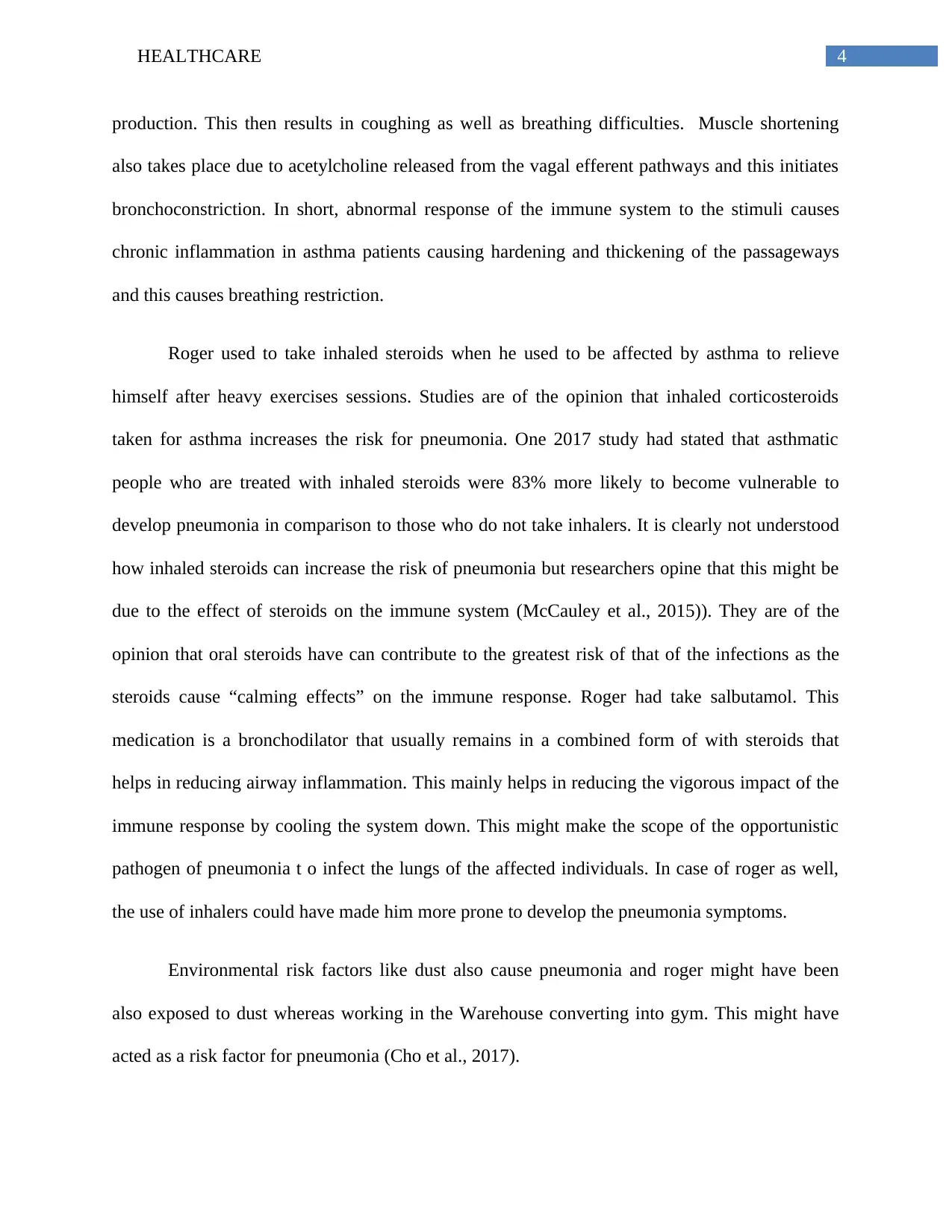
4HEALTHCARE
production. This then results in coughing as well as breathing difficulties. Muscle shortening
also takes place due to acetylcholine released from the vagal efferent pathways and this initiates
bronchoconstriction. In short, abnormal response of the immune system to the stimuli causes
chronic inflammation in asthma patients causing hardening and thickening of the passageways
and this causes breathing restriction.
Roger used to take inhaled steroids when he used to be affected by asthma to relieve
himself after heavy exercises sessions. Studies are of the opinion that inhaled corticosteroids
taken for asthma increases the risk for pneumonia. One 2017 study had stated that asthmatic
people who are treated with inhaled steroids were 83% more likely to become vulnerable to
develop pneumonia in comparison to those who do not take inhalers. It is clearly not understood
how inhaled steroids can increase the risk of pneumonia but researchers opine that this might be
due to the effect of steroids on the immune system (McCauley et al., 2015)). They are of the
opinion that oral steroids have can contribute to the greatest risk of that of the infections as the
steroids cause “calming effects” on the immune response. Roger had take salbutamol. This
medication is a bronchodilator that usually remains in a combined form of with steroids that
helps in reducing airway inflammation. This mainly helps in reducing the vigorous impact of the
immune response by cooling the system down. This might make the scope of the opportunistic
pathogen of pneumonia t o infect the lungs of the affected individuals. In case of roger as well,
the use of inhalers could have made him more prone to develop the pneumonia symptoms.
Environmental risk factors like dust also cause pneumonia and roger might have been
also exposed to dust whereas working in the Warehouse converting into gym. This might have
acted as a risk factor for pneumonia (Cho et al., 2017).
production. This then results in coughing as well as breathing difficulties. Muscle shortening
also takes place due to acetylcholine released from the vagal efferent pathways and this initiates
bronchoconstriction. In short, abnormal response of the immune system to the stimuli causes
chronic inflammation in asthma patients causing hardening and thickening of the passageways
and this causes breathing restriction.
Roger used to take inhaled steroids when he used to be affected by asthma to relieve
himself after heavy exercises sessions. Studies are of the opinion that inhaled corticosteroids
taken for asthma increases the risk for pneumonia. One 2017 study had stated that asthmatic
people who are treated with inhaled steroids were 83% more likely to become vulnerable to
develop pneumonia in comparison to those who do not take inhalers. It is clearly not understood
how inhaled steroids can increase the risk of pneumonia but researchers opine that this might be
due to the effect of steroids on the immune system (McCauley et al., 2015)). They are of the
opinion that oral steroids have can contribute to the greatest risk of that of the infections as the
steroids cause “calming effects” on the immune response. Roger had take salbutamol. This
medication is a bronchodilator that usually remains in a combined form of with steroids that
helps in reducing airway inflammation. This mainly helps in reducing the vigorous impact of the
immune response by cooling the system down. This might make the scope of the opportunistic
pathogen of pneumonia t o infect the lungs of the affected individuals. In case of roger as well,
the use of inhalers could have made him more prone to develop the pneumonia symptoms.
Environmental risk factors like dust also cause pneumonia and roger might have been
also exposed to dust whereas working in the Warehouse converting into gym. This might have
acted as a risk factor for pneumonia (Cho et al., 2017).
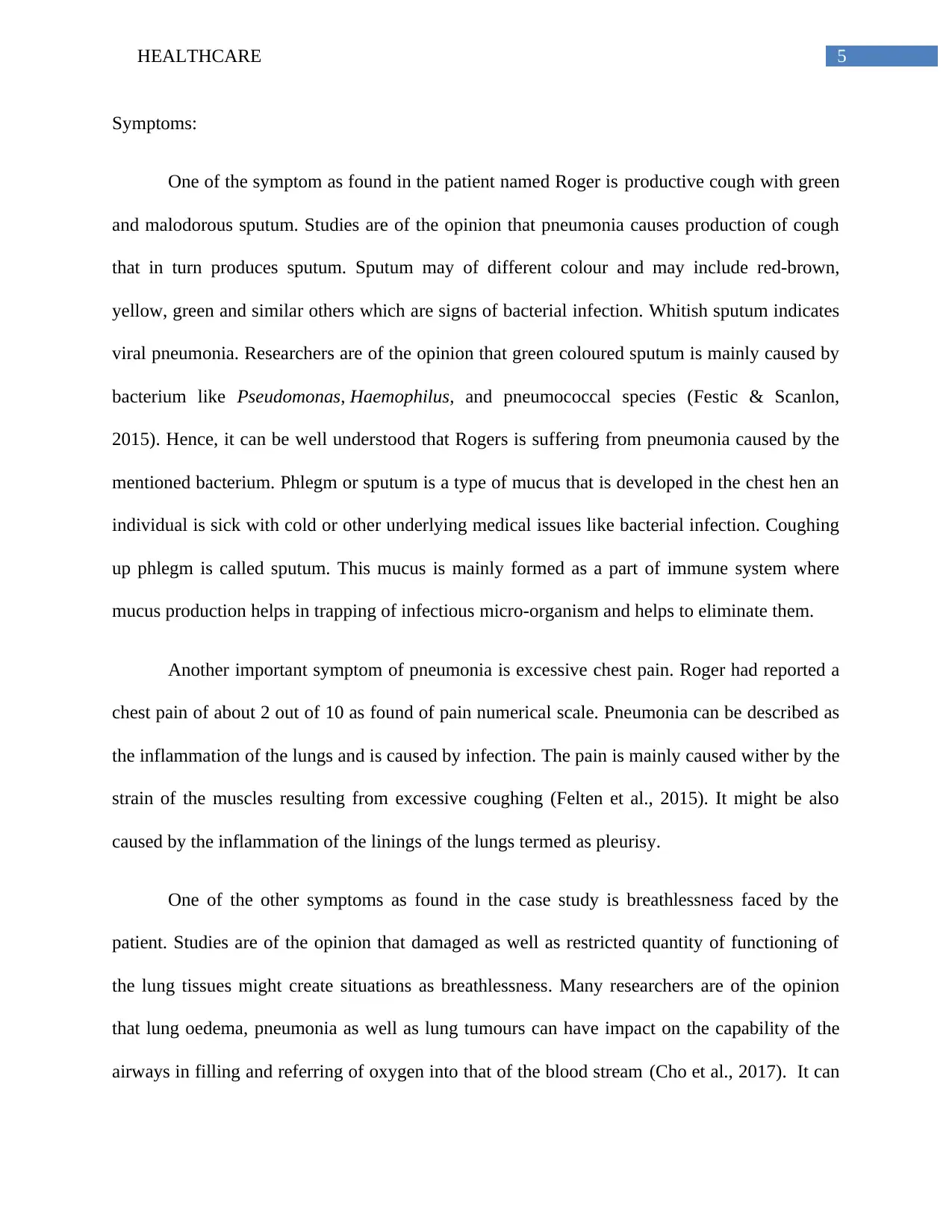
5HEALTHCARE
Symptoms:
One of the symptom as found in the patient named Roger is productive cough with green
and malodorous sputum. Studies are of the opinion that pneumonia causes production of cough
that in turn produces sputum. Sputum may of different colour and may include red-brown,
yellow, green and similar others which are signs of bacterial infection. Whitish sputum indicates
viral pneumonia. Researchers are of the opinion that green coloured sputum is mainly caused by
bacterium like Pseudomonas, Haemophilus, and pneumococcal species (Festic & Scanlon,
2015). Hence, it can be well understood that Rogers is suffering from pneumonia caused by the
mentioned bacterium. Phlegm or sputum is a type of mucus that is developed in the chest hen an
individual is sick with cold or other underlying medical issues like bacterial infection. Coughing
up phlegm is called sputum. This mucus is mainly formed as a part of immune system where
mucus production helps in trapping of infectious micro-organism and helps to eliminate them.
Another important symptom of pneumonia is excessive chest pain. Roger had reported a
chest pain of about 2 out of 10 as found of pain numerical scale. Pneumonia can be described as
the inflammation of the lungs and is caused by infection. The pain is mainly caused wither by the
strain of the muscles resulting from excessive coughing (Felten et al., 2015). It might be also
caused by the inflammation of the linings of the lungs termed as pleurisy.
One of the other symptoms as found in the case study is breathlessness faced by the
patient. Studies are of the opinion that damaged as well as restricted quantity of functioning of
the lung tissues might create situations as breathlessness. Many researchers are of the opinion
that lung oedema, pneumonia as well as lung tumours can have impact on the capability of the
airways in filling and referring of oxygen into that of the blood stream (Cho et al., 2017). It can
Symptoms:
One of the symptom as found in the patient named Roger is productive cough with green
and malodorous sputum. Studies are of the opinion that pneumonia causes production of cough
that in turn produces sputum. Sputum may of different colour and may include red-brown,
yellow, green and similar others which are signs of bacterial infection. Whitish sputum indicates
viral pneumonia. Researchers are of the opinion that green coloured sputum is mainly caused by
bacterium like Pseudomonas, Haemophilus, and pneumococcal species (Festic & Scanlon,
2015). Hence, it can be well understood that Rogers is suffering from pneumonia caused by the
mentioned bacterium. Phlegm or sputum is a type of mucus that is developed in the chest hen an
individual is sick with cold or other underlying medical issues like bacterial infection. Coughing
up phlegm is called sputum. This mucus is mainly formed as a part of immune system where
mucus production helps in trapping of infectious micro-organism and helps to eliminate them.
Another important symptom of pneumonia is excessive chest pain. Roger had reported a
chest pain of about 2 out of 10 as found of pain numerical scale. Pneumonia can be described as
the inflammation of the lungs and is caused by infection. The pain is mainly caused wither by the
strain of the muscles resulting from excessive coughing (Felten et al., 2015). It might be also
caused by the inflammation of the linings of the lungs termed as pleurisy.
One of the other symptoms as found in the case study is breathlessness faced by the
patient. Studies are of the opinion that damaged as well as restricted quantity of functioning of
the lung tissues might create situations as breathlessness. Many researchers are of the opinion
that lung oedema, pneumonia as well as lung tumours can have impact on the capability of the
airways in filling and referring of oxygen into that of the blood stream (Cho et al., 2017). It can
⊘ This is a preview!⊘
Do you want full access?
Subscribe today to unlock all pages.

Trusted by 1+ million students worldwide
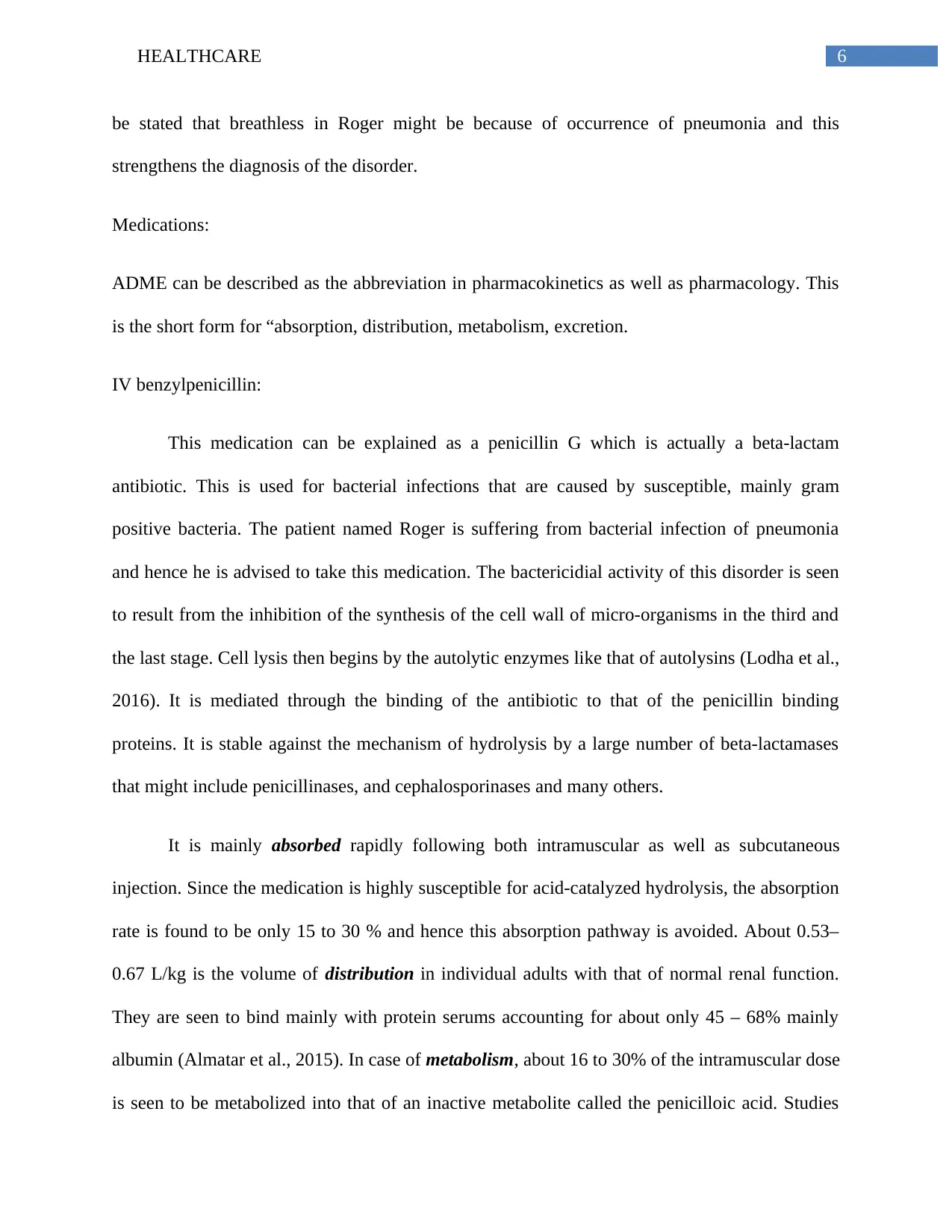
6HEALTHCARE
be stated that breathless in Roger might be because of occurrence of pneumonia and this
strengthens the diagnosis of the disorder.
Medications:
ADME can be described as the abbreviation in pharmacokinetics as well as pharmacology. This
is the short form for “absorption, distribution, metabolism, excretion.
IV benzylpenicillin:
This medication can be explained as a penicillin G which is actually a beta-lactam
antibiotic. This is used for bacterial infections that are caused by susceptible, mainly gram
positive bacteria. The patient named Roger is suffering from bacterial infection of pneumonia
and hence he is advised to take this medication. The bactericidial activity of this disorder is seen
to result from the inhibition of the synthesis of the cell wall of micro-organisms in the third and
the last stage. Cell lysis then begins by the autolytic enzymes like that of autolysins (Lodha et al.,
2016). It is mediated through the binding of the antibiotic to that of the penicillin binding
proteins. It is stable against the mechanism of hydrolysis by a large number of beta-lactamases
that might include penicillinases, and cephalosporinases and many others.
It is mainly absorbed rapidly following both intramuscular as well as subcutaneous
injection. Since the medication is highly susceptible for acid-catalyzed hydrolysis, the absorption
rate is found to be only 15 to 30 % and hence this absorption pathway is avoided. About 0.53–
0.67 L/kg is the volume of distribution in individual adults with that of normal renal function.
They are seen to bind mainly with protein serums accounting for about only 45 – 68% mainly
albumin (Almatar et al., 2015). In case of metabolism, about 16 to 30% of the intramuscular dose
is seen to be metabolized into that of an inactive metabolite called the penicilloic acid. Studies
be stated that breathless in Roger might be because of occurrence of pneumonia and this
strengthens the diagnosis of the disorder.
Medications:
ADME can be described as the abbreviation in pharmacokinetics as well as pharmacology. This
is the short form for “absorption, distribution, metabolism, excretion.
IV benzylpenicillin:
This medication can be explained as a penicillin G which is actually a beta-lactam
antibiotic. This is used for bacterial infections that are caused by susceptible, mainly gram
positive bacteria. The patient named Roger is suffering from bacterial infection of pneumonia
and hence he is advised to take this medication. The bactericidial activity of this disorder is seen
to result from the inhibition of the synthesis of the cell wall of micro-organisms in the third and
the last stage. Cell lysis then begins by the autolytic enzymes like that of autolysins (Lodha et al.,
2016). It is mediated through the binding of the antibiotic to that of the penicillin binding
proteins. It is stable against the mechanism of hydrolysis by a large number of beta-lactamases
that might include penicillinases, and cephalosporinases and many others.
It is mainly absorbed rapidly following both intramuscular as well as subcutaneous
injection. Since the medication is highly susceptible for acid-catalyzed hydrolysis, the absorption
rate is found to be only 15 to 30 % and hence this absorption pathway is avoided. About 0.53–
0.67 L/kg is the volume of distribution in individual adults with that of normal renal function.
They are seen to bind mainly with protein serums accounting for about only 45 – 68% mainly
albumin (Almatar et al., 2015). In case of metabolism, about 16 to 30% of the intramuscular dose
is seen to be metabolized into that of an inactive metabolite called the penicilloic acid. Studies
Paraphrase This Document
Need a fresh take? Get an instant paraphrase of this document with our AI Paraphraser
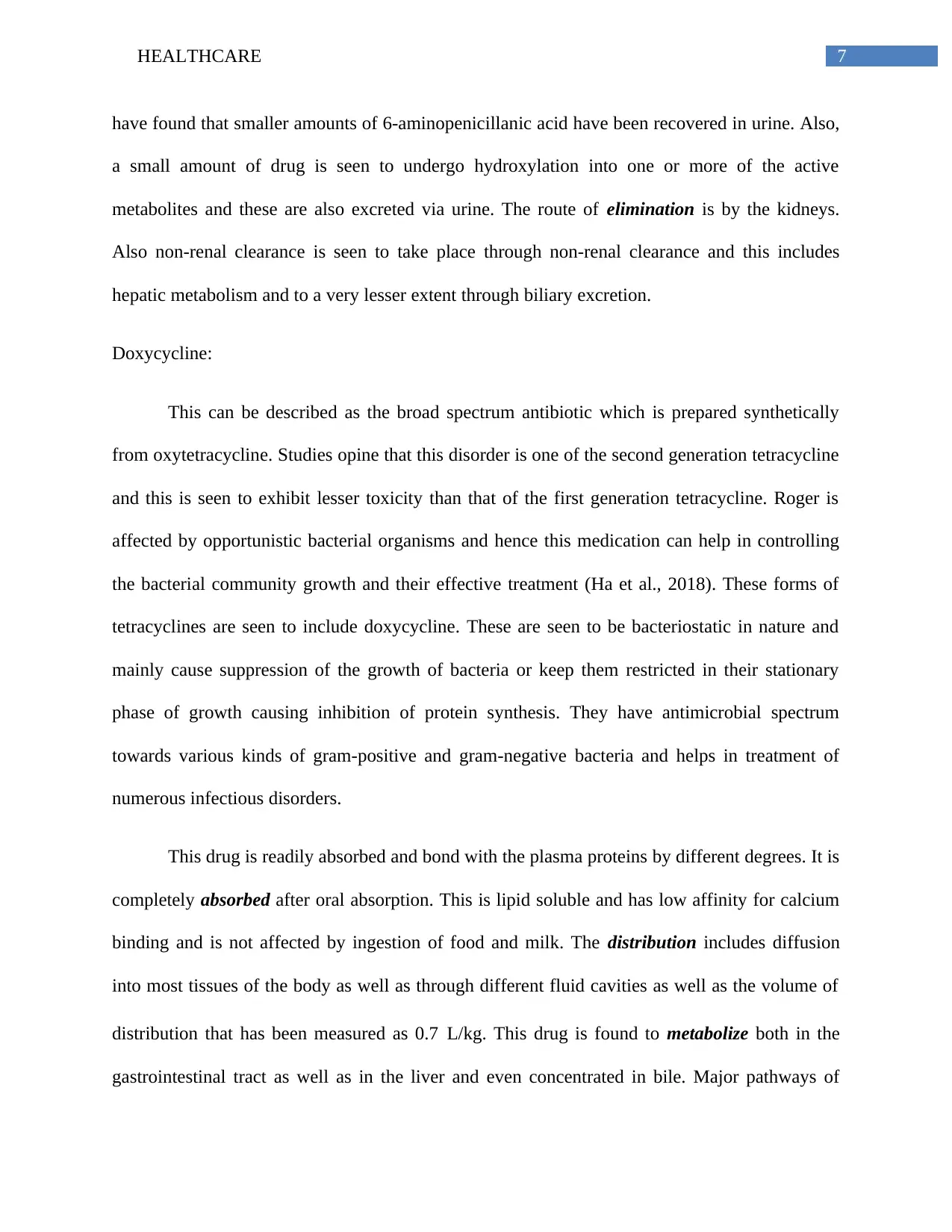
7HEALTHCARE
have found that smaller amounts of 6-aminopenicillanic acid have been recovered in urine. Also,
a small amount of drug is seen to undergo hydroxylation into one or more of the active
metabolites and these are also excreted via urine. The route of elimination is by the kidneys.
Also non-renal clearance is seen to take place through non-renal clearance and this includes
hepatic metabolism and to a very lesser extent through biliary excretion.
Doxycycline:
This can be described as the broad spectrum antibiotic which is prepared synthetically
from oxytetracycline. Studies opine that this disorder is one of the second generation tetracycline
and this is seen to exhibit lesser toxicity than that of the first generation tetracycline. Roger is
affected by opportunistic bacterial organisms and hence this medication can help in controlling
the bacterial community growth and their effective treatment (Ha et al., 2018). These forms of
tetracyclines are seen to include doxycycline. These are seen to be bacteriostatic in nature and
mainly cause suppression of the growth of bacteria or keep them restricted in their stationary
phase of growth causing inhibition of protein synthesis. They have antimicrobial spectrum
towards various kinds of gram-positive and gram-negative bacteria and helps in treatment of
numerous infectious disorders.
This drug is readily absorbed and bond with the plasma proteins by different degrees. It is
completely absorbed after oral absorption. This is lipid soluble and has low affinity for calcium
binding and is not affected by ingestion of food and milk. The distribution includes diffusion
into most tissues of the body as well as through different fluid cavities as well as the volume of
distribution that has been measured as 0.7 L/kg. This drug is found to metabolize both in the
gastrointestinal tract as well as in the liver and even concentrated in bile. Major pathways of
have found that smaller amounts of 6-aminopenicillanic acid have been recovered in urine. Also,
a small amount of drug is seen to undergo hydroxylation into one or more of the active
metabolites and these are also excreted via urine. The route of elimination is by the kidneys.
Also non-renal clearance is seen to take place through non-renal clearance and this includes
hepatic metabolism and to a very lesser extent through biliary excretion.
Doxycycline:
This can be described as the broad spectrum antibiotic which is prepared synthetically
from oxytetracycline. Studies opine that this disorder is one of the second generation tetracycline
and this is seen to exhibit lesser toxicity than that of the first generation tetracycline. Roger is
affected by opportunistic bacterial organisms and hence this medication can help in controlling
the bacterial community growth and their effective treatment (Ha et al., 2018). These forms of
tetracyclines are seen to include doxycycline. These are seen to be bacteriostatic in nature and
mainly cause suppression of the growth of bacteria or keep them restricted in their stationary
phase of growth causing inhibition of protein synthesis. They have antimicrobial spectrum
towards various kinds of gram-positive and gram-negative bacteria and helps in treatment of
numerous infectious disorders.
This drug is readily absorbed and bond with the plasma proteins by different degrees. It is
completely absorbed after oral absorption. This is lipid soluble and has low affinity for calcium
binding and is not affected by ingestion of food and milk. The distribution includes diffusion
into most tissues of the body as well as through different fluid cavities as well as the volume of
distribution that has been measured as 0.7 L/kg. This drug is found to metabolize both in the
gastrointestinal tract as well as in the liver and even concentrated in bile. Major pathways of
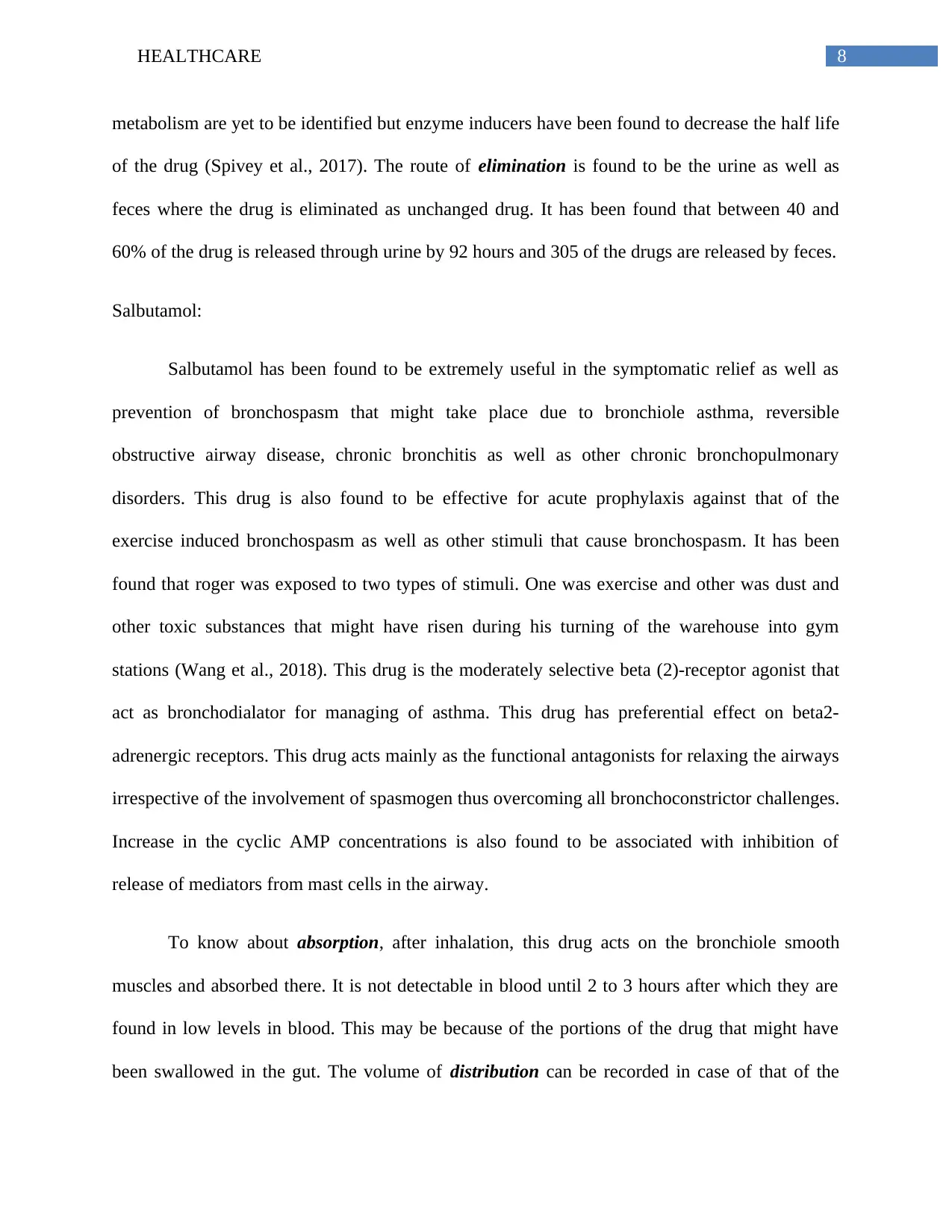
8HEALTHCARE
metabolism are yet to be identified but enzyme inducers have been found to decrease the half life
of the drug (Spivey et al., 2017). The route of elimination is found to be the urine as well as
feces where the drug is eliminated as unchanged drug. It has been found that between 40 and
60% of the drug is released through urine by 92 hours and 305 of the drugs are released by feces.
Salbutamol:
Salbutamol has been found to be extremely useful in the symptomatic relief as well as
prevention of bronchospasm that might take place due to bronchiole asthma, reversible
obstructive airway disease, chronic bronchitis as well as other chronic bronchopulmonary
disorders. This drug is also found to be effective for acute prophylaxis against that of the
exercise induced bronchospasm as well as other stimuli that cause bronchospasm. It has been
found that roger was exposed to two types of stimuli. One was exercise and other was dust and
other toxic substances that might have risen during his turning of the warehouse into gym
stations (Wang et al., 2018). This drug is the moderately selective beta (2)-receptor agonist that
act as bronchodialator for managing of asthma. This drug has preferential effect on beta2-
adrenergic receptors. This drug acts mainly as the functional antagonists for relaxing the airways
irrespective of the involvement of spasmogen thus overcoming all bronchoconstrictor challenges.
Increase in the cyclic AMP concentrations is also found to be associated with inhibition of
release of mediators from mast cells in the airway.
To know about absorption, after inhalation, this drug acts on the bronchiole smooth
muscles and absorbed there. It is not detectable in blood until 2 to 3 hours after which they are
found in low levels in blood. This may be because of the portions of the drug that might have
been swallowed in the gut. The volume of distribution can be recorded in case of that of the
metabolism are yet to be identified but enzyme inducers have been found to decrease the half life
of the drug (Spivey et al., 2017). The route of elimination is found to be the urine as well as
feces where the drug is eliminated as unchanged drug. It has been found that between 40 and
60% of the drug is released through urine by 92 hours and 305 of the drugs are released by feces.
Salbutamol:
Salbutamol has been found to be extremely useful in the symptomatic relief as well as
prevention of bronchospasm that might take place due to bronchiole asthma, reversible
obstructive airway disease, chronic bronchitis as well as other chronic bronchopulmonary
disorders. This drug is also found to be effective for acute prophylaxis against that of the
exercise induced bronchospasm as well as other stimuli that cause bronchospasm. It has been
found that roger was exposed to two types of stimuli. One was exercise and other was dust and
other toxic substances that might have risen during his turning of the warehouse into gym
stations (Wang et al., 2018). This drug is the moderately selective beta (2)-receptor agonist that
act as bronchodialator for managing of asthma. This drug has preferential effect on beta2-
adrenergic receptors. This drug acts mainly as the functional antagonists for relaxing the airways
irrespective of the involvement of spasmogen thus overcoming all bronchoconstrictor challenges.
Increase in the cyclic AMP concentrations is also found to be associated with inhibition of
release of mediators from mast cells in the airway.
To know about absorption, after inhalation, this drug acts on the bronchiole smooth
muscles and absorbed there. It is not detectable in blood until 2 to 3 hours after which they are
found in low levels in blood. This may be because of the portions of the drug that might have
been swallowed in the gut. The volume of distribution can be recorded in case of that of the
⊘ This is a preview!⊘
Do you want full access?
Subscribe today to unlock all pages.

Trusted by 1+ million students worldwide
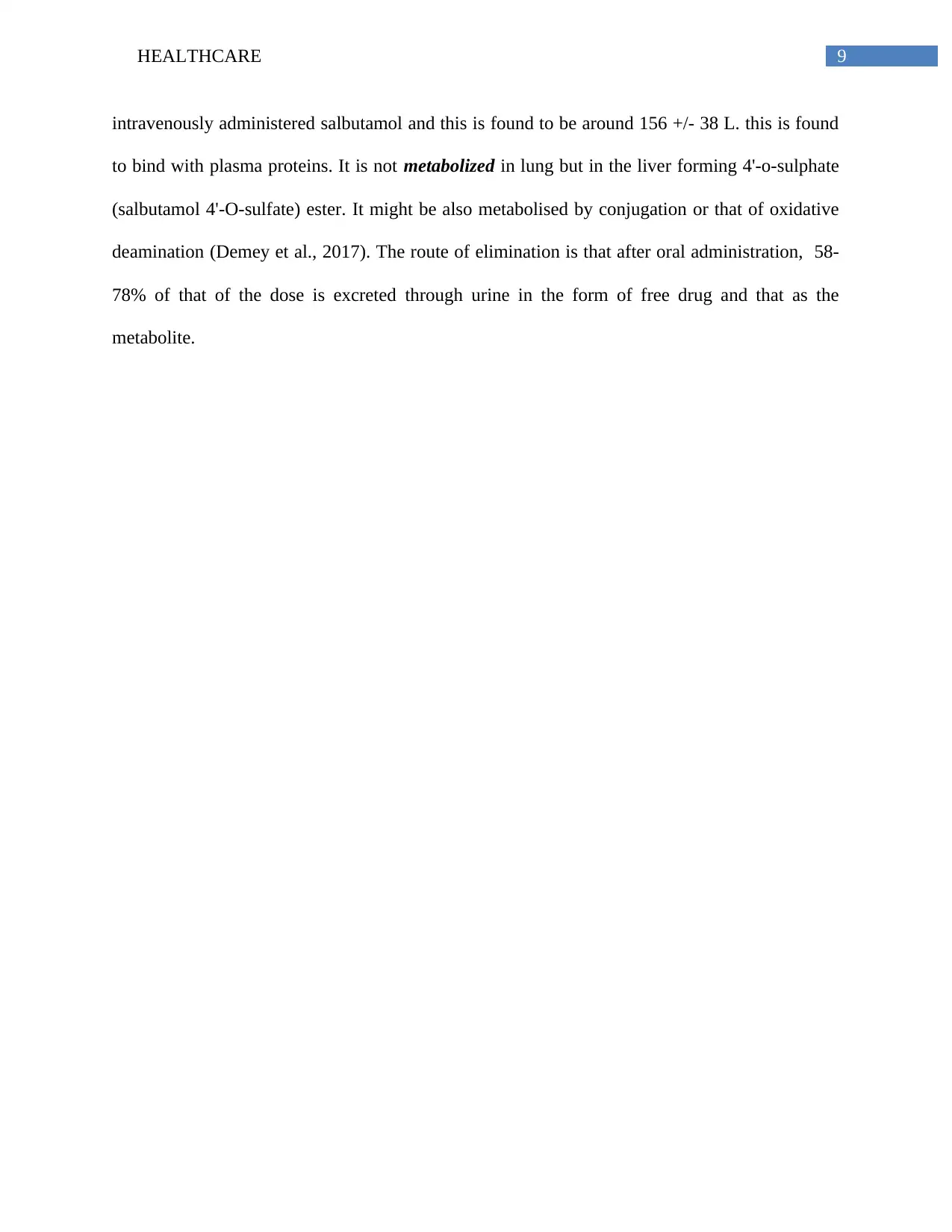
9HEALTHCARE
intravenously administered salbutamol and this is found to be around 156 +/- 38 L. this is found
to bind with plasma proteins. It is not metabolized in lung but in the liver forming 4'-o-sulphate
(salbutamol 4'-O-sulfate) ester. It might be also metabolised by conjugation or that of oxidative
deamination (Demey et al., 2017). The route of elimination is that after oral administration, 58-
78% of that of the dose is excreted through urine in the form of free drug and that as the
metabolite.
intravenously administered salbutamol and this is found to be around 156 +/- 38 L. this is found
to bind with plasma proteins. It is not metabolized in lung but in the liver forming 4'-o-sulphate
(salbutamol 4'-O-sulfate) ester. It might be also metabolised by conjugation or that of oxidative
deamination (Demey et al., 2017). The route of elimination is that after oral administration, 58-
78% of that of the dose is excreted through urine in the form of free drug and that as the
metabolite.
Paraphrase This Document
Need a fresh take? Get an instant paraphrase of this document with our AI Paraphraser
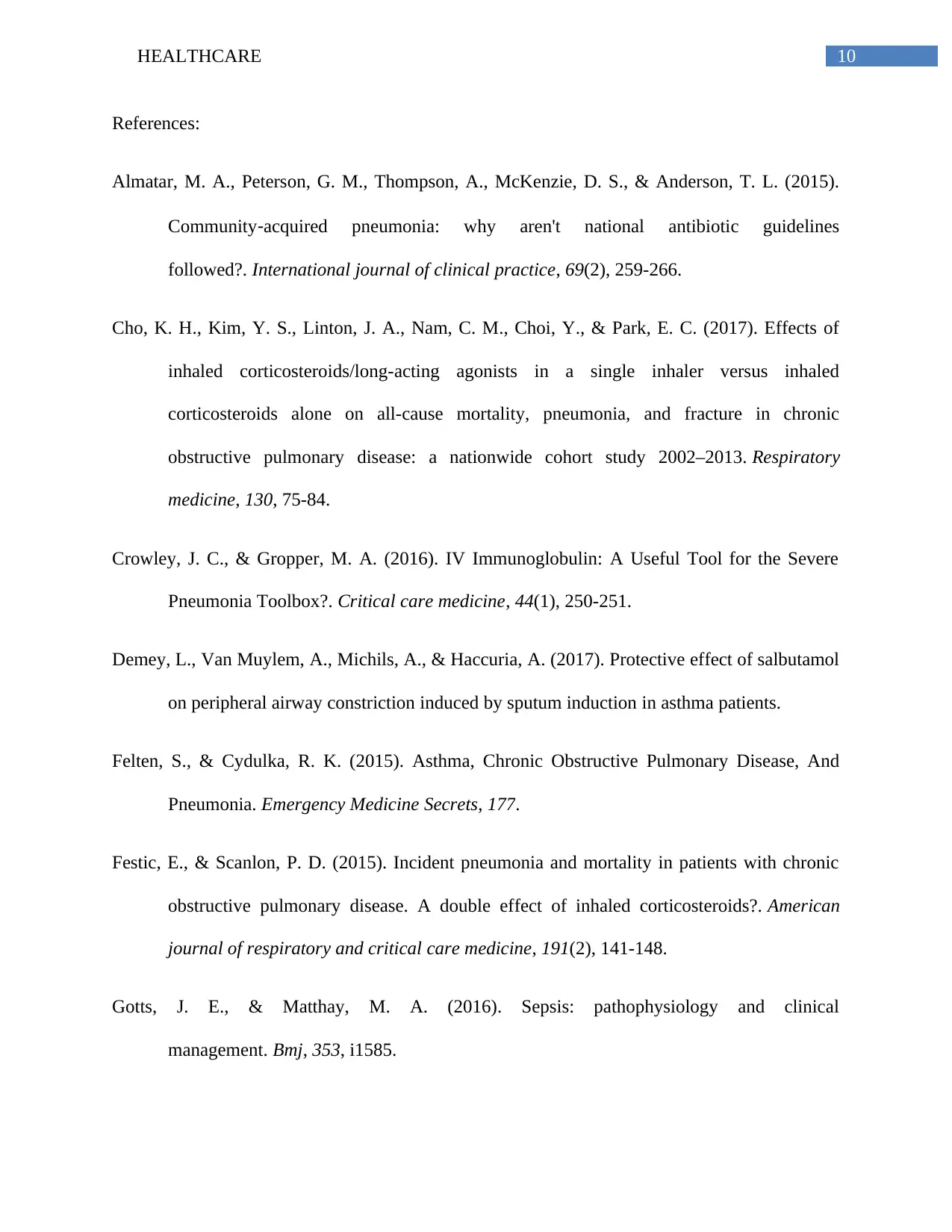
10HEALTHCARE
References:
Almatar, M. A., Peterson, G. M., Thompson, A., McKenzie, D. S., & Anderson, T. L. (2015).
Community‐acquired pneumonia: why aren't national antibiotic guidelines
followed?. International journal of clinical practice, 69(2), 259-266.
Cho, K. H., Kim, Y. S., Linton, J. A., Nam, C. M., Choi, Y., & Park, E. C. (2017). Effects of
inhaled corticosteroids/long-acting agonists in a single inhaler versus inhaled
corticosteroids alone on all-cause mortality, pneumonia, and fracture in chronic
obstructive pulmonary disease: a nationwide cohort study 2002–2013. Respiratory
medicine, 130, 75-84.
Crowley, J. C., & Gropper, M. A. (2016). IV Immunoglobulin: A Useful Tool for the Severe
Pneumonia Toolbox?. Critical care medicine, 44(1), 250-251.
Demey, L., Van Muylem, A., Michils, A., & Haccuria, A. (2017). Protective effect of salbutamol
on peripheral airway constriction induced by sputum induction in asthma patients.
Felten, S., & Cydulka, R. K. (2015). Asthma, Chronic Obstructive Pulmonary Disease, And
Pneumonia. Emergency Medicine Secrets, 177.
Festic, E., & Scanlon, P. D. (2015). Incident pneumonia and mortality in patients with chronic
obstructive pulmonary disease. A double effect of inhaled corticosteroids?. American
journal of respiratory and critical care medicine, 191(2), 141-148.
Gotts, J. E., & Matthay, M. A. (2016). Sepsis: pathophysiology and clinical
management. Bmj, 353, i1585.
References:
Almatar, M. A., Peterson, G. M., Thompson, A., McKenzie, D. S., & Anderson, T. L. (2015).
Community‐acquired pneumonia: why aren't national antibiotic guidelines
followed?. International journal of clinical practice, 69(2), 259-266.
Cho, K. H., Kim, Y. S., Linton, J. A., Nam, C. M., Choi, Y., & Park, E. C. (2017). Effects of
inhaled corticosteroids/long-acting agonists in a single inhaler versus inhaled
corticosteroids alone on all-cause mortality, pneumonia, and fracture in chronic
obstructive pulmonary disease: a nationwide cohort study 2002–2013. Respiratory
medicine, 130, 75-84.
Crowley, J. C., & Gropper, M. A. (2016). IV Immunoglobulin: A Useful Tool for the Severe
Pneumonia Toolbox?. Critical care medicine, 44(1), 250-251.
Demey, L., Van Muylem, A., Michils, A., & Haccuria, A. (2017). Protective effect of salbutamol
on peripheral airway constriction induced by sputum induction in asthma patients.
Felten, S., & Cydulka, R. K. (2015). Asthma, Chronic Obstructive Pulmonary Disease, And
Pneumonia. Emergency Medicine Secrets, 177.
Festic, E., & Scanlon, P. D. (2015). Incident pneumonia and mortality in patients with chronic
obstructive pulmonary disease. A double effect of inhaled corticosteroids?. American
journal of respiratory and critical care medicine, 191(2), 141-148.
Gotts, J. E., & Matthay, M. A. (2016). Sepsis: pathophysiology and clinical
management. Bmj, 353, i1585.
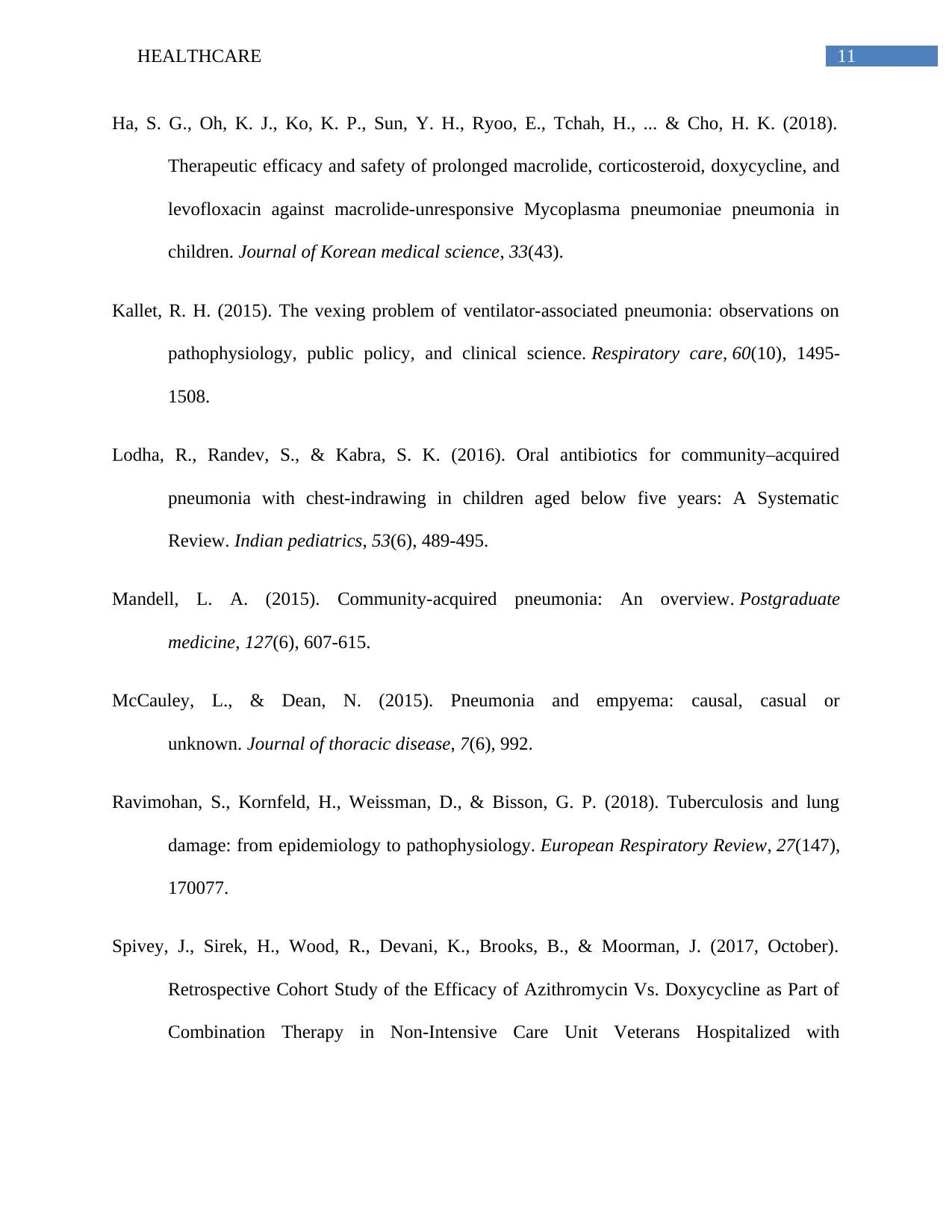
11HEALTHCARE
Ha, S. G., Oh, K. J., Ko, K. P., Sun, Y. H., Ryoo, E., Tchah, H., ... & Cho, H. K. (2018).
Therapeutic efficacy and safety of prolonged macrolide, corticosteroid, doxycycline, and
levofloxacin against macrolide-unresponsive Mycoplasma pneumoniae pneumonia in
children. Journal of Korean medical science, 33(43).
Kallet, R. H. (2015). The vexing problem of ventilator-associated pneumonia: observations on
pathophysiology, public policy, and clinical science. Respiratory care, 60(10), 1495-
1508.
Lodha, R., Randev, S., & Kabra, S. K. (2016). Oral antibiotics for community–acquired
pneumonia with chest-indrawing in children aged below five years: A Systematic
Review. Indian pediatrics, 53(6), 489-495.
Mandell, L. A. (2015). Community-acquired pneumonia: An overview. Postgraduate
medicine, 127(6), 607-615.
McCauley, L., & Dean, N. (2015). Pneumonia and empyema: causal, casual or
unknown. Journal of thoracic disease, 7(6), 992.
Ravimohan, S., Kornfeld, H., Weissman, D., & Bisson, G. P. (2018). Tuberculosis and lung
damage: from epidemiology to pathophysiology. European Respiratory Review, 27(147),
170077.
Spivey, J., Sirek, H., Wood, R., Devani, K., Brooks, B., & Moorman, J. (2017, October).
Retrospective Cohort Study of the Efficacy of Azithromycin Vs. Doxycycline as Part of
Combination Therapy in Non-Intensive Care Unit Veterans Hospitalized with
Ha, S. G., Oh, K. J., Ko, K. P., Sun, Y. H., Ryoo, E., Tchah, H., ... & Cho, H. K. (2018).
Therapeutic efficacy and safety of prolonged macrolide, corticosteroid, doxycycline, and
levofloxacin against macrolide-unresponsive Mycoplasma pneumoniae pneumonia in
children. Journal of Korean medical science, 33(43).
Kallet, R. H. (2015). The vexing problem of ventilator-associated pneumonia: observations on
pathophysiology, public policy, and clinical science. Respiratory care, 60(10), 1495-
1508.
Lodha, R., Randev, S., & Kabra, S. K. (2016). Oral antibiotics for community–acquired
pneumonia with chest-indrawing in children aged below five years: A Systematic
Review. Indian pediatrics, 53(6), 489-495.
Mandell, L. A. (2015). Community-acquired pneumonia: An overview. Postgraduate
medicine, 127(6), 607-615.
McCauley, L., & Dean, N. (2015). Pneumonia and empyema: causal, casual or
unknown. Journal of thoracic disease, 7(6), 992.
Ravimohan, S., Kornfeld, H., Weissman, D., & Bisson, G. P. (2018). Tuberculosis and lung
damage: from epidemiology to pathophysiology. European Respiratory Review, 27(147),
170077.
Spivey, J., Sirek, H., Wood, R., Devani, K., Brooks, B., & Moorman, J. (2017, October).
Retrospective Cohort Study of the Efficacy of Azithromycin Vs. Doxycycline as Part of
Combination Therapy in Non-Intensive Care Unit Veterans Hospitalized with
⊘ This is a preview!⊘
Do you want full access?
Subscribe today to unlock all pages.

Trusted by 1+ million students worldwide
1 out of 13
Related Documents
Your All-in-One AI-Powered Toolkit for Academic Success.
+13062052269
info@desklib.com
Available 24*7 on WhatsApp / Email
![[object Object]](/_next/static/media/star-bottom.7253800d.svg)
Unlock your academic potential
Copyright © 2020–2025 A2Z Services. All Rights Reserved. Developed and managed by ZUCOL.





